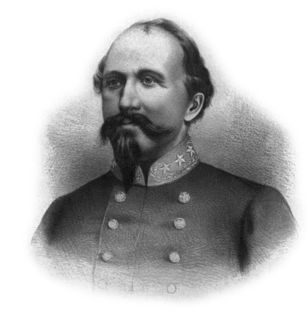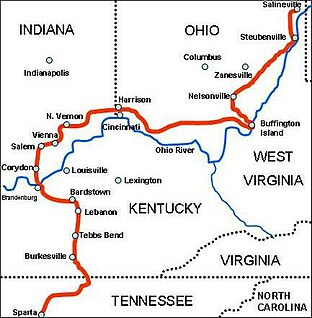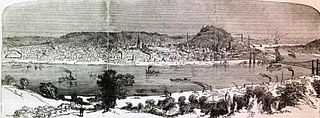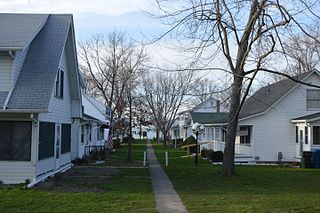George Hatch was a Democratic politician, who served as Mayor of the City of Cincinnati, Ohio, during the American Civil War from 1861 to 1863. [1]

The Democratic Party is one of the two major contemporary political parties in the United States, along with its rival, the Republican Party. Tracing its heritage back to Thomas Jefferson and James Madison's Democratic-Republican Party, the modern-day Democratic Party was founded around 1828 by supporters of Andrew Jackson, making it the world's oldest active political party.

The American Civil War was a civil war fought in the United States from 1861 to 1865, between the North and the South. The Civil War began primarily as a result of the long-standing controversy over the enslavement of black people. War broke out in April 1861 when secessionist forces attacked Fort Sumter in South Carolina shortly after Abraham Lincoln had been inaugurated as the President of the United States. The loyalists of the Union in the North, which also included some geographically western and southern states, proclaimed support for the Constitution. They faced secessionists of the Confederate States in the South, who advocated for states' rights in order to uphold slavery.
In late spring 1862, Cincinnati city officials recognized the threat of an attack from Confederate forces under the command of Brig. Gen. John Hunt Morgan, who was riding northward through Kentucky apparently intent on crossing the Ohio River into Indiana and/or Ohio. Numerous militia groups had been organized, but the threat of nearly 2,000 veteran cavalrymen riding into downtown Cincinnati prompted Mayor George Hatch to release a proclamation calling out the local citizenry into action for the defense of Cincinnati.

The Confederate States Army was the military land force of the Confederate States of America during the American Civil War (1861–1865), fighting against the United States forces. On February 28, 1861, the Provisional Confederate Congress established a provisional volunteer army and gave control over military operations and authority for mustering state forces and volunteers to the newly chosen Confederate president, Jefferson Davis. Davis was a graduate of the U.S. Military Academy, and colonel of a volunteer regiment during the Mexican–American War. He had also been a United States Senator from Mississippi and U.S. Secretary of War under President Franklin Pierce. On March 1, 1861, on behalf of the Confederate government, Davis assumed control of the military situation at Charleston, South Carolina, where South Carolina state militia besieged Fort Sumter in Charleston harbor, held by a small U.S. Army garrison. By March 1861, the Provisional Confederate Congress expanded the provisional forces and established a more permanent Confederate States Army.

John Hunt Morgan was a Confederate general in the American Civil War.

Kentucky, officially the Commonwealth of Kentucky, is a state located in the east south-central region of the United States. Although styled as the "State of Kentucky" in the law creating it,, Kentucky is one of four U.S. states constituted as a commonwealth. Originally a part of Virginia, in 1792 Kentucky split from it and became the 15th state to join the Union. Kentucky is the 37th most extensive and the 26th most populous of the 50 United States.
- "In accordance with a resolution passed by the City Council of Cincinnati on the 1st instant, I hereby request that all business, of every kind or character, be suspended at ten o’clock of this day, that all persons, employers and employees, assemble in their respective wards, at the usual places of voting, and there organize themselves in such manner as may be thought best for the defense of the city. Every man, of every age, be he citizen or alien, who lives under the protection of our laws, is expected to take part in the organization. Witness my hand, and the corporate seal of the city of Cincinnati, this second day of September, A.D. 1862". [2]
At two o'clock on the morning of the same day, Mayor Hatch issued another proclamation, notifying the citizens that the police force would perform the duty of a provost-guard, under the direction of Gen. Lew Wallace. On September 2, 1862 despite the protests of Mayor George Hatch, the Army ordered a unit of black men, known as the Black Brigade of Cincinnati, to dig fortifications in Northern Kentucky. [3]

Lewis Wallace was an American lawyer, Union general in the American Civil War, governor of the New Mexico Territory, politician, diplomat, and author from Indiana. Among his novels and biographies, Wallace is best known for his historical adventure story, Ben-Hur: A Tale of the Christ (1880), a bestselling novel that has been called "the most influential Christian book of the nineteenth century."

The Black Brigade of Cincinnati was a military unit of African-American soldiers, that was organized in 1862 during the American Civil War, when the city of Cincinnati, Ohio, was in danger of being attacked, by the Confederate Army. The members of the Cincinnati "Black Brigade" were among the very first African Americans to be employed in the military defense of the Union.

Northern Kentucky is the third-largest metropolitan area in the U.S. Commonwealth of Kentucky after Louisville and Lexington, and its cities and towns serve as the de facto "south side" communities of Cincinnati, Ohio. The three main counties of this metro area are Boone, Kenton, and Campbell counties along the Ohio River, with other counties also included. The label "Northern Kentucky" is used to demonstrate the common identity shared across county and city lines by the residents of these northern counties. Arguably, the label seeks to reverse the divisions that occurred to Campbell County, which, in 1794, included the land of Boone, Kenton, Pendleton counties, and most of Bracken and Grant counties. The urban and suburban areas of the northern counties are densely populated. Indeed, of Greater Cincinnati's over two million residents 447,457 of the residents live in Northern Kentucky, with the three most northern counties contributing 390,736 residents themselves. The largest cities in each of the three northernmost counties are Covington the largest city in northern Kentucky, and the largest city in Kenton County, Florence the largest city in Boone County, and Newport, the largest city in Campbell County.
Mayor Hatch's former home is located at 830 Dayton Street, in the Dayton Street Historic District. Locals named the house "Hatch's Folly" because of its size and pretentious design. [4]

The Dayton Street Historic District is located in the Old West End neighborhood of Cincinnati, Ohio, United States. It was once known as "Millionaires' Row" for the prominent industrialists who resided in a row of opulent mansions built between 1850 and 1890. It is bounded by Bank Street, Poplar Street, Linn Street, and Winchell Avenue. The district was designated and listed on the National Register of Historic Places on January 25, 1973.

















